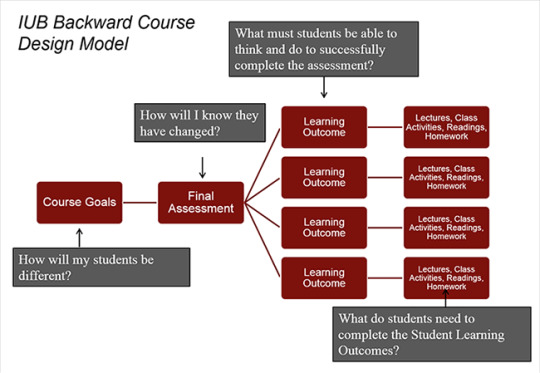End of semester reflections from Foundations of Learning (ESDT1000U). I completed this course in the Spring/Semester 2023 semester, taught by Dr. Christian D. Elias at Ontario Tech University.
Don't wanna be here? Send us removal request.
Text
Reflecting on Week 9 | Backwards Design and the Instructional Design Process
In my work providing reference support to library users, whether in the public or academic setting, I did not consider the backwards design process when providing one on one consultation or instruction to visitors. In this line of work, we have RUSA guidelines to walk information staff through the reference interview process. Rather than identifying learning goals appropriate for group instruction, I was merely focused on finding thorough ways to approach users’ questions.
Through this program, I’m hoping to expand on my skill set and opportunities as an educator in the post secondary sector. Part of the skills’ exploration and development is familiarizing myself with learning theories and models suited to different contexts, and being able to define the most appropriate models to use. Much of the work in the BA ESDT program has me considering using a Backwards Design approach for instructional sessions, either led by myself or other librarians in undergraduate classrooms at my current workplace, OCAD University. I’m also considering backwards design when creating asynchronous tools, such as quick reference guides for various accessibility software I work with, like Kurzweil.
Prior to the BA ESDT program, I would not have been able to name a learning theory, aside from maybe Behaviorism if my life depended on it. Now, the concept of Backwards Design is a familiar one, having used it to design courses in both Assessment for Learning and Instructional Design.
For those unfamiliar, Backwards Design is a learning model that plans learning experiences with the final assessment in mind. This is done by designing the lesson plan in these three stages, in the following order:
Identifying Desired Results
Determine Acceptable Evidence of Learning
Design Learning Experiences and Instruction
You can see these steps outlined below:

In Week 9 of our readings for Foundations of Learning, my peers and I were introduced to Stuart E. Dreyfus’s 5-Stage Model of Adult Skill Acquisition. Essentially, this model scores learners’ skill level on a 5 point, chronological and hierarchical level from novice, advanced beginner, competency, proficiency and expertise. Within these levels, instructional designers can define what skills learners should attain, and by what standards. The example given in the readings was learning to drive, and comparing what a competent driver can do comfortably compared to a beginner.
You can learn more about Dreyfus’s 5-Stage Model for Adult Skill Acquisition here:
youtube
In this context, and as a relevant example, I am trying to come up with a one page handout to help students register for Kurzweil with their OCAD U login credentials and get them started with the Kurzweil Read the Web Google Chrome extension. With this extension, users would be able to have text in PDFs or plain HTML included in their Canvas course pages converted from text to speech. Integrating Dreyfus’s 5-Stage Model of Skill Acquisition for Adults, I can see what skills I’d want a new Kurzweil Read the Web user to be familiar with. I can consider which functions within the Chrome extension would be considered advanced. What skills would be better suited for a one on one demonstration with a requestor? What would crowd the handout?
By incorporating the 5-levels of Learning for Adults, instructional designers are able to create precise learning goals and scaffold activities based on learners’ familiarity with the content. That way, learning goals are set for the duration of instruction, rather than the end of the lesson.
[Note that hyperlinks for an APA formatted reference sheet did not format properly in Tumblr. A separate References document was submitted in Canvas for this assignment in ESDT1000U and can be made available upon request in Word or PDF formats.]
#dreyfus' five stage model#backward design#backwards design#kurzweil3000#kurzweil read the web#library reference#library instruction#accessibility software#Youtube
0 notes